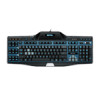Logitech G510s Gaming Software Guide - Page 10
Using the Device bar, Displays the Customize Pointer Settings View
 |
View all Logitech G510s manuals
Add to My Manuals
Save this manual to your list of manuals |
Page 10 highlights
Using the Device bar The Device bar at the bottom of the Logitech® Gaming Software screen offers various icons. You are not be able to see all of these icons, as they are only available for the actions supported by your gaming device. Below is the full list of icons and an explanation of each: Icon Action Launches the Logitech website. Shows your device. If you have more than one supported gaming device plugged in, the device currently selected is displayed. Any settings you change in the Logitech Gaming Software will be applied to just this device. To change settings for a different device, click the or button next to the device icon and choose the device you require. Returns to the Logitech Gaming Software Home page, showing an image of your gaming device. Pressing Esc also re-displays the Home page. Displays the Profiles View, used to create and maintain profiles for your games. The icon shown on the Device bar depends on whether the device you have selected contains G-keys or mouse buttons. If your device has on-board memory, you may be able to store G-key/button settings on the device. Displays the Customize LCD Display View, used to control the information and material displayed on your device's LCD display. Displays the Customize Pointer Settings View, used to configure device pointer movement settings to suit you and your gaming. If your device has on-board memory, you may be able to store pointer settings on the device. Displays the Customize On-Board Profile Settings View, used to set profiles and pointer movement settings stored on the gaming device. Displays the Manage Profiles To Go View, used to store certain game settings on the device so you can take it to other computers and your profiles go with it. Displays the Customize Backlight Color View (or for the G300, the Profiles View), where you can set the color scheme for your gaming device. If your device has on-board memory, you may be able to store lighting settings on the device.















